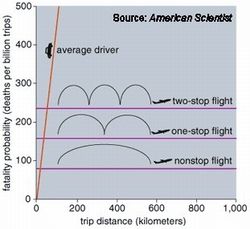Don't Drive, if Ya Want to Stay Alive...
If you're traveleing more than about 12 miles, fly.
 That's not the actual conclusion of a study
published in the January-February issue of American
Scientist; but it can be extrapolated from their data, and
they say so.
That's not the actual conclusion of a study
published in the January-February issue of American
Scientist; but it can be extrapolated from their data, and
they say so.
What's wrong with the study:
Any study such as this is necessarily limited, given that
commercial flying and driving are different, in most-basic ways.
Drivers are usually alone, and control their vehicles; and they
make the go/no-go decisions. None of that obtains in commercial air
travel.
The most-important obvious difference seen when comparing these
radically-different data, is that fatalities are most-common in
different modes: in flying, the takeoff/landing modes
account for 95% of fatalities; in driving, the distance per leg is
the determinant -- the longer the leg, the greater the chance of
the driver's being involved in a fatal accident.
The study included 2001 data; thus, it included September 11's
terrorist attacks, and the 18% drop in airline RPMs that followed.
The driving data were pulled from 2000, the latest year from which
such statistics were available.
 The study looked at just the ten largest airlines.
On the "car" side, it considered deaths to drivers only; passenger
deaths were not included. (Car passenger survival wasn't
included, either; but the great majority of car trips are taken
solo.) Of course, when a major airline flight goes successfully, a
LOT of passenger-miles are added to the total. (Vehicle-mile safety
data were not compared.)
The study looked at just the ten largest airlines.
On the "car" side, it considered deaths to drivers only; passenger
deaths were not included. (Car passenger survival wasn't
included, either; but the great majority of car trips are taken
solo.) Of course, when a major airline flight goes successfully, a
LOT of passenger-miles are added to the total. (Vehicle-mile safety
data were not compared.)
Partially offsetting the use of major airline data, was the use,
for car drivers, of interstate traffic figures only. Commuter
airlines have historically-higher death rates than majors (due
to number of passengers carried, airports used, an numbers of
takeoffs/landings); and most auto fatalities occur on
non-limited-access roadways.
 Those
two groups' being studied, therefore, are roughly analogous. (Hey
-- it's close enough to give an idea; since the two modes are so
different, what's your method of comparison?)
Those
two groups' being studied, therefore, are roughly analogous. (Hey
-- it's close enough to give an idea; since the two modes are so
different, what's your method of comparison?)
Buses, motorcycles, and semis were excluded from the highway
death tolls.
So, given the limitations of the study, what did they find
out?
With airlines, the best chance of your getting killed is when
the plane is taking off or landing. Therefore, you are better-off
flying direct, whenever possible. In your car, the death rate
increases, as the length of the drive increases. Therefore, you're
better-off making frequent stops.
As the journal summarized, "Just how much safer is flying than
driving? For an average-length nonstop flight (which works out to
1,157 kilometers), the risk of flying is just the 78.6 X 10–9
value derived above. The risk of driving those same 1,157
kilometers is 1,157 X 4.4 X 10–9, or 5,091 X 10–9.
Dividing 5,091 by 78.6, we estimate that driving the length of a
typical nonstop segment is approximately 65 times as risky as
flying. Driving farther than 1,157 kilometers would be more than 65
times as risky; driving shorter than 1,157 kilometers, but longer
than the 18-kilometer indifference distance, would be between 1 and
65 times as risky as nonstop flying (neglecting the drive to the
airport and the travel on local roads on the way to the
interstate)."
 [The
extra time involved in short-hop airline flights (travel, two-hour
recommended "security hassle" time, rental car snafys at the
destination) was not considered; but it would surely affect
mortality rate, as it adds so much to one's blood pressure, while
it literally shortens one's useful life, by wasting time. That's
another reason to drive the shorter distances, although it's not
really related to the question at hand --ed.]
[The
extra time involved in short-hop airline flights (travel, two-hour
recommended "security hassle" time, rental car snafys at the
destination) was not considered; but it would surely affect
mortality rate, as it adds so much to one's blood pressure, while
it literally shortens one's useful life, by wasting time. That's
another reason to drive the shorter distances, although it's not
really related to the question at hand --ed.]
 ANN's Daily Aero-Term (05.09.24): Hold Procedure
ANN's Daily Aero-Term (05.09.24): Hold Procedure ANN's Daily Aero-Term (05.06.24): Altitude Readout
ANN's Daily Aero-Term (05.06.24): Altitude Readout ANN's Daily Aero-Linx (05.06.24)
ANN's Daily Aero-Linx (05.06.24) Airborne-NextGen 05.07.24: AI-Piloted F-16, AgEagle, 1st 2 WorldView Sats
Airborne-NextGen 05.07.24: AI-Piloted F-16, AgEagle, 1st 2 WorldView Sats Aero-News: Quote of the Day (05.07.24)
Aero-News: Quote of the Day (05.07.24)






